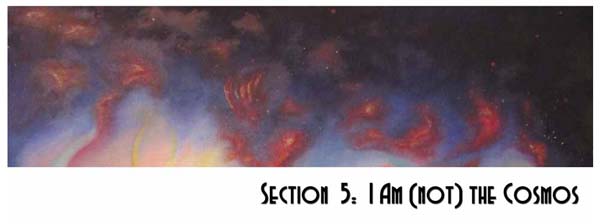a literary journal published by the Black Earth Institute dedicated to re-forging the links between art and spirit, earth and society

Humans, it appears, are always anticipating the apocalypse. That, too, seems a sequela of the primal paradox: our collective selves at peril from some menacing Other which turns out to be intimately Us: Will we perish from the flood brought on by our own sins, the nuclear destruction caused by our fear of each other, or the climate crisis that results from our collective greed. Our attempts to assert our independence and our preeminence as individuals and as a species have consequences for the whole in which we live. The whole is like the proverbial tar baby that we can’t separate from. In fact, our efforts to separate only further entangle us.
Perhaps quantum mechanics provides the model for our bifurcated engagement with the reality we construct out of the mysterious conditions we find ourselves in. Should we view ourselves as separate particles or, as physicist David Bohm envisioned, as an entangled, “implicate order” spread through the universe in which everything is? In trying to answer that question our consciousness needs to acknowledge itself as both plural and individual. Bohm described an individual person as a vortex in a stream, relatively separate yet in reality composed of what flows through it: an image of the primal paradox.
In a recent New York Review of Books article reviewing a book on the history of genius (the exceptional individual), Prof. Tamsin Shaw observes that we are fascinated with genius because the genius both asserts an individuality and transcends it to answer “the human demand for what Thomas Nagel has called the ‘yearning for cosmic reconciliation,’ that is for a way of living in harmony (being connected “intelligibly and, if possible satisfyingly”) with the whole of reality…” (“Wonder Boys?” Oct 9, 2014, p 4).
Historically and cross-culturally, human thought has constantly returned to the issue of harmony and balance. Balancing the opposing terms of the primal paradox is mirrored in calls to seek balance in our lives as a whole. Such balance appears in the Bhagavad Gita’s recommendation to pursue a moderation “which destroys all sorrow.” It appears in Buddha’s invocation of “the middle path” to freedom from suffering; in the Greek idea of “moderation in all things.” It appears prominently in Chinese philosophy: for example, in the philosophy of the Dao, and in the concept of chi, which forms the central theme of the I Ching, Book of Changes. Moderation appears in the important Navaho concept of Hozho, the life force of balance and beauty that often needs to be refreshed and restored. (Humans now currently live in what the Navaho call Koyaanisqatsi, a life “out of balance.”)
Concern for finding the balance of individual parts with an indivisible whole pervades the design of self-governance laid out in the U.S. Constitution.
Think of it this way: moving through the world as individuals we’re like a walker on a tightrope above an abyss. The aerialist sways left and right, forward and backward, constantly seeking and relocating his center of gravity in the buffeting currents of the surrounding atmosphere and his own internal vibrations. Again and again he must become one with the wire and the air if he is to survive. If the individual on the wire cannot understand himself as inseparable from whole he will cease to exist as an individual.
Art has always been a sacred space where our struggles with the primal paradox are made clear to our senses. Here’s one example:
In a visionary scene from director Terrence Malick’s film “The Tree of Life” a small, deer-like dinosaur lies sick, perhaps dying, on the cobbles of a Jurassic river. It is approached by a predator dinosaur. The predator places a claw on the small dinosaur’s head as if preparing to kill it. But then the predator releases its grip. The small prey stirs, tries to rise. The predator pushes the claw back to keep it down, but then withdraws its claw again and hesitates, almost tenderly reaching toward the face and pulling back, refraining, an utterly ambiguous gesture either reassuring or warning — before turning away to leave the smaller animal behind. It’s almost as if we are seeing the birth of empathy in the universe: empathy as a state of being in which the individual recognizes the condition of the other as if it were the self: a primordial golden rule. This scene set in the primal gloom of the evolving cosmos is echoed throughout Malick’s film by scenes depicting a young boy’s life as he struggles to love and reconcile with his family and authoritarian father.
The premise of this issue of About Place is that the primal paradox is a central condition animating our lives and that recognizing and reflecting on that condition may help us puzzle out some of dilemmas life raises for us. If we can’t resolve or escape the primal paradox, there’s plenty of evidence to show that we can use our awareness of it to make beauty and harmony in our swiftly flowing lives.
©2025 Black Earth Institute. All rights reserved. | ISSN# 2327-784X | Site Admin